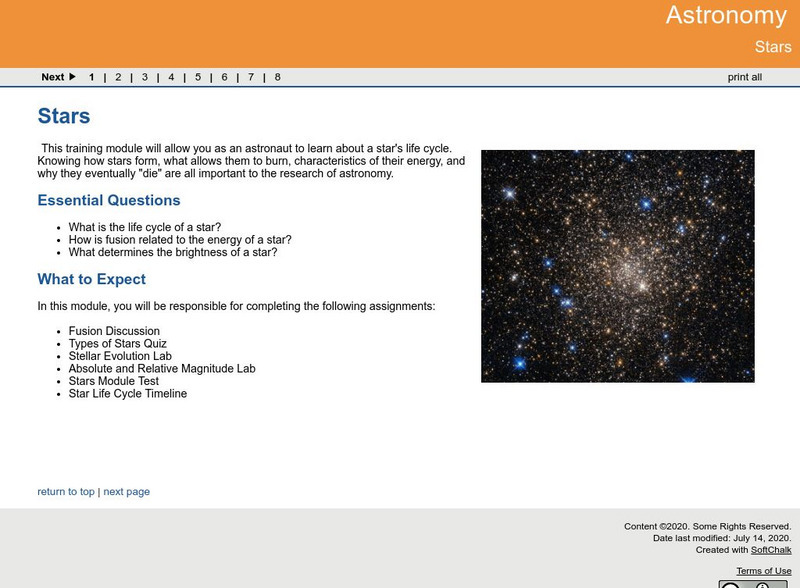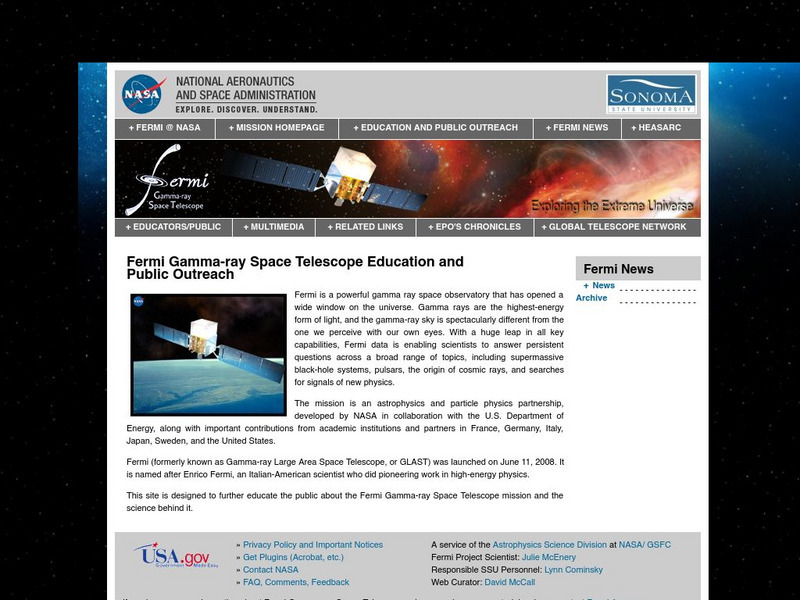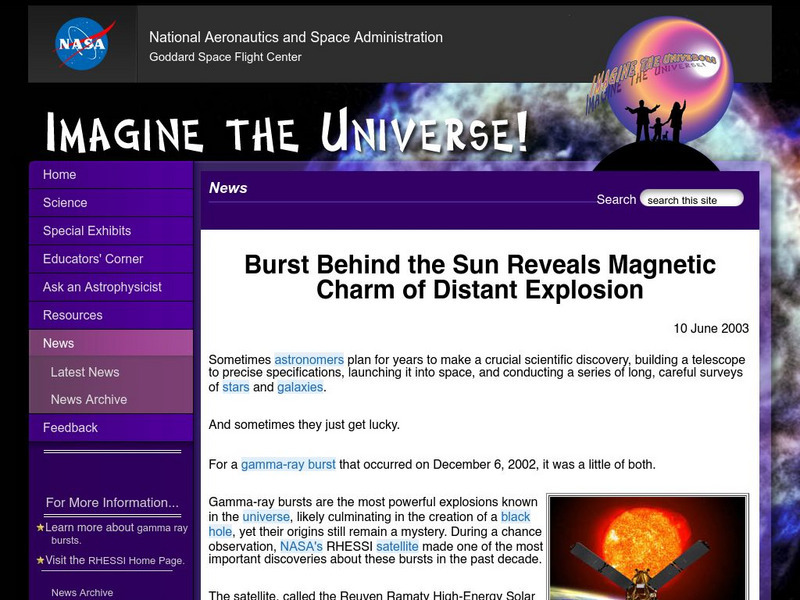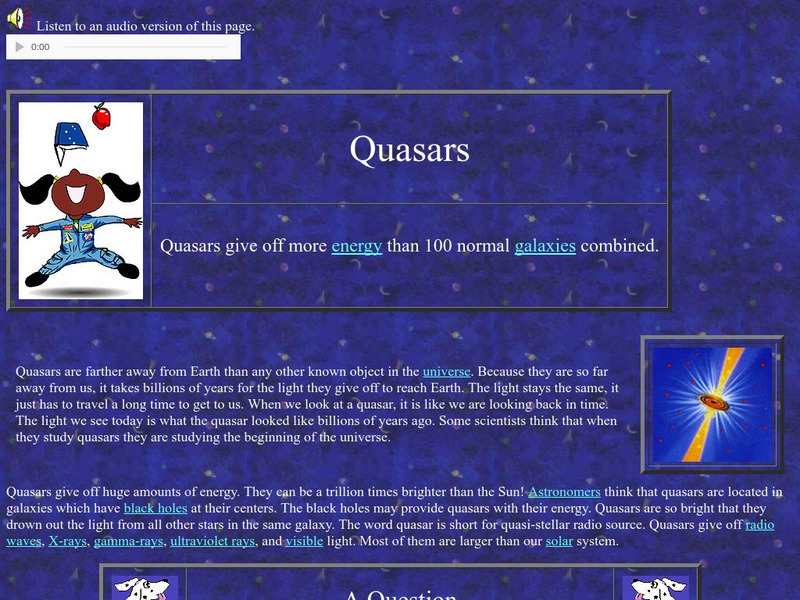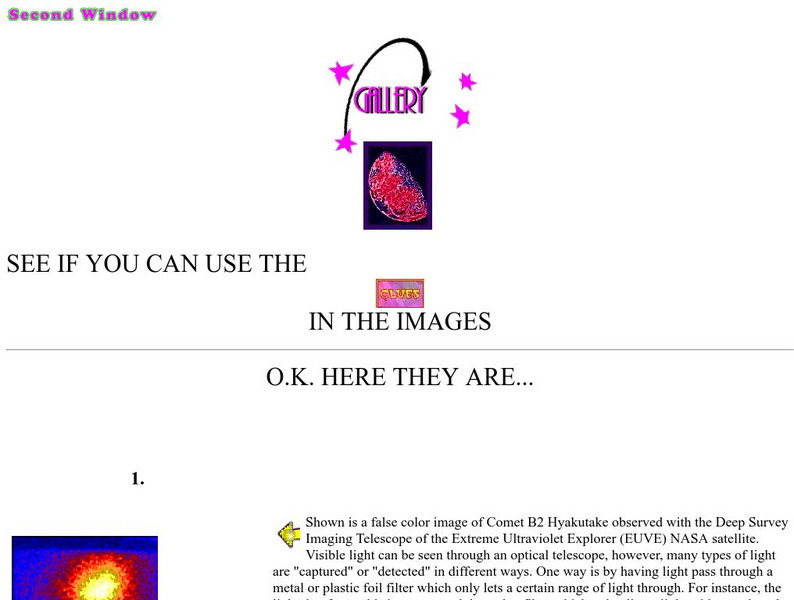Curated OER
Get the Picture!
Astronomers practice downloading data from a high-energy satellite and translate the data into colored or shaded pixels. As a hands-on activity, they use pennies to simulate high-energy satellite data and they convert their penny...
Curated OER
What Wavelength Was That?
A combination of informative text, photos, and graphics comprise this sharp show on electromagnetic radiation. Some slides mention hands-on activities for demonstrating concepts, so if you want to include them you will need to figure out...
Curated OER
Making Waves with the Electromagnetic Spectrum
Students examine different types of electromagnetic waves and their sources. In this electromagnetic waves lesson students view a video and complete a handout.
Curated OER
Astronomer sees a 'Brake' in Cosmic expansion
Seventh graders examine and read an article. In this investigative lesson students discuss questions about the article and complete an activity.
PBS
Pbs Learning Media: Gamma Ray Burst Theories
This video segment from Swift: Eyes through Time introduces and explains theories of the origin of gamma-ray bursts. [4:11]
University of Hawai'i
Univ. Of Hawaii: The Effects of Gamma Rays on Mars Rocks
This site from the University of Hawaii describes the results of experiments to use gamma rays to sterilize rocks from outer space.
Atomic Archive
Nuclear Fusion: The Hydrogen Bomb
From the Atomic Archive - the online companion to the award-winning CD-ROM. This page (and the couple that follow from it) describe the use of fusion reactions in a hydrogen bomb. A schematic diagram of an H-bomb is given and discussed....
Other
Le Moyne College:elements & Atoms, Indivisible No Longer
Click to read different historical documents in chemistry related to the history of the study and discovery of radioactivity.
Georgia Department of Education
Ga Virtual Learning: Stars
In this interactive module students will explore the life cycle of stars and how they produce energy.
PBS
Pbs Learning Media: The Electromagnetic Spectrum: Frontline
This video segment adapted from FRONTLINE introduces the electromagnetic spectrum and explains how the various types of electromagnetic waves are distinguished by the amount of energy each wave carries.
Georgia State University
Georgia State University: Hyper Physics: Relativistic Energy
A mathematically understandable presentation of relativistic energy. Parts include Relativistic Energy, Rest Mass Energy, Conservation of Energy, Pair Production, Relativistic Kinetic Energy, and even Kinetic Energy. A couple of...
University of California
U.c. Berkeley: Spectra From Space
View the entire spectrum of electromagnetic radiation and get information on telescopes especially designed to view different wavelengths of the spectrum.
University of Colorado
University of Colorado: Physics 2000: Positrons, Alpha Particles, Gamma Rays
An interactive tutorial on positrons. Very readible and has a little extra for the advanced student.
Sonoma State University
The Gamma Ray Large Area Space Telescope (Glast)
Background information on gamma rays and the sources of gamma rays in the universe. Discusses the purpose of the GLAST space mission and the types of findings which they wish to make. A link to the GLAST movie provides an excellent...
NASA
Nasa: Imagine the Universe: Gamma Ray Bursts
What is a Gamma-ray Burst? Why do scientists study gamma-ray bursts? Find your answers to these questions as well as view additional resources on this topic.
NASA
Nasa: Imagine the Universe: "Burst Behind the Sun"
Site provides the article, "Burst Behind the Sun Reveals Magnetic Charm of Distant Explosion," that details on a gamma-ray burst that occurred on December 6, 2002. Provides graphics and links to learn more about gamma-ray bursts.
NASA
Nasa: Imagine the Universe: Gamma Ray Bursts
Use this site to learn all about gamma-ray bursts. Site provides links to models and other more detailed information, a movie, and links to other resources.
NASA
Nasa: Imagine the Universe: The History of Gamma Ray Astronomy
This NASA article discusses the history of gamma-ray astronomy. Related resources.
CK-12 Foundation
Ck 12: Physical Science: Gamma Decay
[Free Registration/Login may be required to access all resource tools.] Explains how and why gamma decay occurs, what gamma rays are, and why gamma radiation is the most harmful.
NASA
Nasa Star Child: Quasars (Level 1)
Learn why quasars are the brightest things in the universe. Vocabulary words linked to a glossary of terms and a printable version are available.
NASA
Nasa Star Child: Comets (Level 1)
Younger students learn why comets race through the sky as well as related vocabulary words and meanings.
NASA
Viewing the Violent Universe: What Are Gamma Rays?
The universe produces a broad range of light, only a fraction of which is visible to our eyes. Gamma rays are nonvisible light, which also includes x-rays, ultraviolet light, infrared radiation, and radio waves.
University of California
Center for Science Education: Gallery
A gallery of astronomy images which depict galaxies, comets, the moon, planets, nebulae, supernovae as seen in various regions of the electromagnetic spectrum. Each image in the gallery is described. Fascinating!
California Institute of Technology
Spitzer Science Center: Gamma Ray Burst
This space telescope image features a full-blown Gamma-Ray Burst first detected by a team of astronomers led by Peter Garnavich. In addition, a detailed textual overview explains various specifics of the picture.









